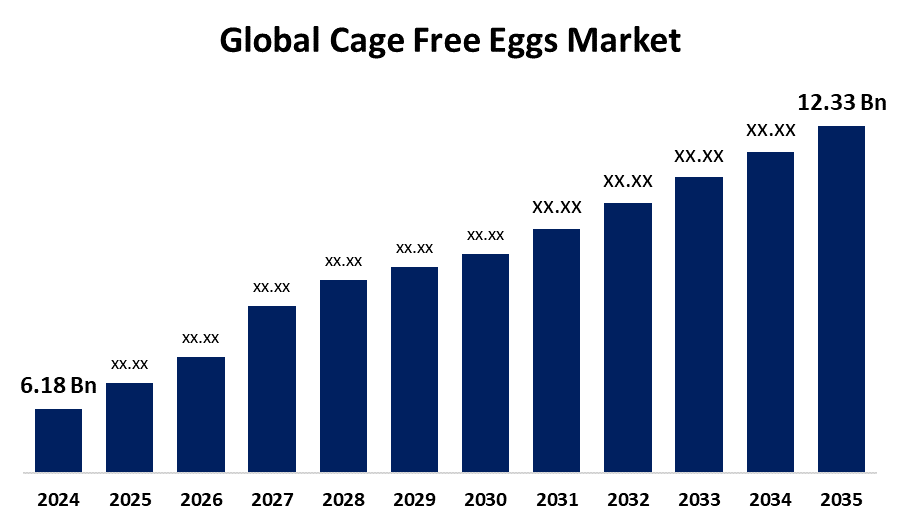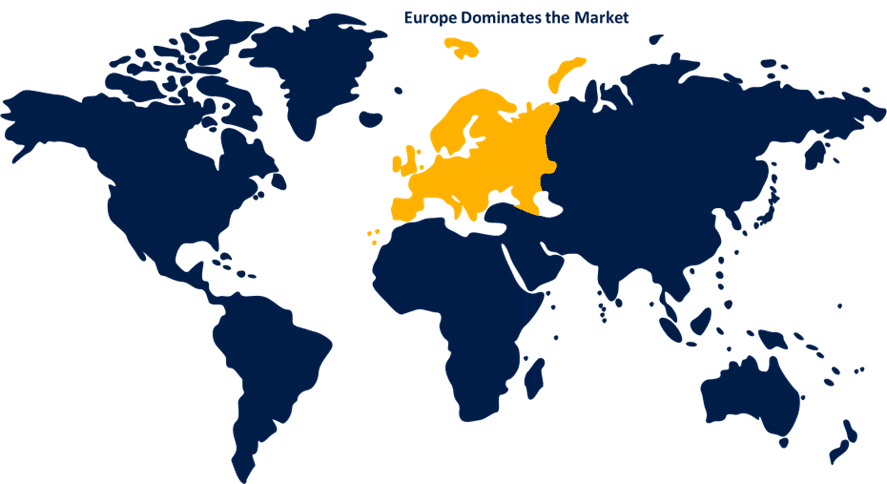Global Cage Free Eggs Market Size, Share, and COVID-19 Impact Analysis, By Product Type (Brown Cage Free Eggs, White Cage Free Eggs, Specialty Cage Free Eggs), By Application (Household, Food Service, Food Processing), By Distribution Channel (Supermarkets/Hypermarkets, Convenience Stores, Online Retail, Specialty Stores, and Others), and By Region (North America, Europe, Asia-Pacific, Latin America, Middle East, and Africa), Analysis and Forecast 2025 - 2035
Industry: Food & BeveragesGlobal Cage Free Eggs Market Insights Forecasts to 2035
- The Global Cage Free Eggs Market Size Was Estimated at USD 6.18 Billion in 2024
- The Market Size is Expected to Grow at a CAGR of around 6.48% from 2025 to 2035
- The Worldwide Cage Free Eggs Market Size is Expected to Reach USD 12.33 Billion by 2035
- Asia Pacific is Expected to Grow the fastest during the forecast period.

Get more details on this report -
The global cage free eggs market size was worth around USD 6.18 billion in 2024 and is predicted to grow to around USD 12.33 billion by 2035 with a compound annual growth rate (CAGR) of 6.48% from 2025 and 2035. The cage-free eggs market is propelled by growing consumer concern for animal welfare, encouraging government policies, corporate social responsibility to source ethically, expanding demand for organic and healthy food, expansion in modern retailing channels, and humane egg production advocacy campaigns.
Market Overview
The cage-free eggs market is the part of the egg market dedicated to producing, distributing, and selling eggs from hens raised without confinement in battery cages. These hens are kept in open indoor spaces where they can move about freely and practice natural behaviors in response to increased consumer demand for humane, ethical, and sustainable food products. Cage-free eggs are viewed as a more ethical alternative to eggs from caged hens since they enable chickens to engage in natural behaviors like walking, nesting, and spreading their wings, which are highly limited in traditional cage systems. Additionally, Consumer preferences are moving more and more towards ethically produced food, and this shift is greatly driven by the work of animal welfare organizations. These organizations have highlighted the usually brutal living conditions of egg-laying hens in conventional cage systems. In turn, both ordinary consumers and big businesses are opting for more humane alternatives. Most major food service companies, retailers, and manufacturers have committed to utilizing only cage-free eggs, causing substantial changes throughout the supply chain and influencing the future of the egg industry.
Report Coverage
This research report categorizes the cage free eggs market based on various segments and regions, forecasts revenue growth, and analyzes trends in each submarket. The report analyses the key growth drivers, opportunities, and challenges influencing the cage free eggs market. Recent market developments and competitive strategies such as expansion, type launch, development, partnership, merger, and acquisition have been included to draw the competitive landscape in the market. The report strategically identifies and profiles the key market players and analyses their core competencies in each sub-segment of the cage free eggs market.
Global Cage Free Eggs Market Report Coverage
| Report Coverage | Details |
|---|---|
| Base Year: | 2024 |
| Market Size in 2024: | USD 6.18 Billion |
| Forecast Period: | 2024-2035 |
| Forecast Period CAGR 2024-2035 : | 6.48% |
| 2035 Value Projection: | USD 12.33 Billion |
| Historical Data for: | 2020-2023 |
| No. of Pages: | 240 |
| Tables, Charts & Figures: | 150 |
| Segments covered: | By Product Type, By Application, By Distribution Channel and COVID-19 Impact Analysis. |
| Companies covered:: | Cal-Maine Foods, Inc., Vital Farms, Inc., Herbruck’s Poultry Ranch, Inc., Hillandale Farms, Rose Acre Farms, Happy Egg Co., Pete and Gerry’s Organic Eggs, Egg Innovations, LLC, Midwest Poultry Services, L.P., Noble Foods Ltd., The Lakes Free Range Egg Company, Sunny Queen Farms, and Others. |
| Pitfalls & Challenges: | COVID-19 Empact,Challenges, Future, Growth, & Analysis |
Get more details on this report -
Driving Factors
More consumers are becoming aware of animal well-being concerns and want to buy products that support ethical farming practices. This trend is moving consumers toward buying cage-free eggs, which are viewed as a more humane option than traditional battery-caged eggs. In addition, cage-free eggs tend to be viewed as healthier and more natural, consistent with the larger trend toward clean-label, organic, and minimally processed food. Health-oriented consumers are driving demand for eggs that are raised without intensive confinement systems.
Restraining Factors
Cage-free egg production is more expensive and demands greater space and attention for hens, making production costs higher than traditional battery cages. Such increased costs are frequently transferred to customers, discouraging price-conscious buyers and hindering widespread acceptance.
Market Segmentation
The cage free eggs market share is classified into product type, application, and distribution channel.
- The white cage free eggs segment dominated the market in 2024 and is projected to grow at a substantial CAGR during the forecast period.
Based on the product type, the cage free eggs market is divided into brown cage free eggs, white cage free eggs, and specialty cage free eggs. Among these, the white cage free eggs segment dominated the market in 2024 and is projected to grow at a substantial CAGR during the forecast period. The growth is driven by white eggs are laid by hens that grow more quickly and use less feed than brown egg-laying hens. This reduces the cost of producing white cage-free eggs, making them cheaper, which appeals to price-sensitive consumers.
- The household segment accounted for a significant share in 2024 and is anticipated to grow at the fastest CAGR during the forecast period.
Based on the application, the cage free eggs market is divided into household, food service, and food processing. Among these, the household segment accounted for a significant share in 2024 and is anticipated to grow at the fastest CAGR during the forecast period. The segmental growth is due to eggs are ubiquitous and versatile foods used in regular meals, including breakfast, baking, and cooking. Their broad use in households worldwide fuels steady demand for cage-free eggs, positioning them as a major product in consumer kitchens.
- The supermarkets/hypermarkets segment accounted for the highest share in 2024 and is anticipated to grow at a significant CAGR during the forecast period.
Based on the distribution channel, the cage free eggs market is divided into supermarkets/hypermarkets, convenience stores, online retail, specialty stores, and others. Among these, the supermarkets/hypermarkets segment accounted for the highest share in 2024 and is anticipated to grow at a significant CAGR during the forecast period. The growth is attributed to shoppers like these outlets for their capability to meet more than one shopping requirement in one visit. Buying groceries, home products, and socially responsible goods such as cage-free eggs, all in one store, provides convenience for frequent and routine purchasing behavior.
Regional Segment Analysis of the Cage Free Eggs Market
- North America (U.S., Canada, Mexico)
- Europe (Germany, France, U.K., Italy, Spain, Rest of Europe)
- Asia-Pacific (China, Japan, India, Rest of APAC)
- South America (Brazil and the Rest of South America)
- The Middle East and Africa (UAE, South Africa, Rest of MEA)
Europe is anticipated to hold the largest share of the cage free eggs market over the predicted timeframe.

Get more details on this report -
Europe is anticipated to hold the largest share of the cage free eggs market over the predicted timeframe. European consumers are becoming more aware of animal welfare and environmental concerns. Such awareness spurs demand for ethically produced food, particularly cage-free eggs. Retailers and foodservice companies react by favoring cage-free supply chains, furthering demand. Public campaigns and non-governmental organizations have also impacted purchasing habits, turning cage-free eggs into a mainstream choice in Europe.
Asia Pacific is expected to grow at a rapid CAGR in the cage free eggs market during the forecast period. Several Asia-Pacific governments and multinational businesses active in the region have implemented policies favoring cage-free and hydroponic farming. These laws and commitments are the driving force behind the change from hydroponic cages, particularly among nations such as Australia, Japan, and China, with the market experiencing fast growth.
North America is predicted to hold a significant share of the cage free eggs market throughout the estimated period. Large American retailers such as Walmart and Costco have committed to 100% cage-free. States such as California and Massachusetts have also passed legislation prohibiting caged eggs, driving adoption along supply chains and solidifying North America's market position.
Competitive Analysis:
The report offers the appropriate analysis of the key organizations/companies involved within the cage free eggs market, along with a comparative evaluation primarily based on their type of offering, business overviews, geographic presence, enterprise strategies, segment market share, and SWOT analysis. The report also provides an elaborative analysis focusing on the current news and developments of the companies, which includes type development, innovations, joint ventures, partnerships, mergers & acquisitions, strategic alliances, and others. This allows for the evaluation of the overall competition within the market.
List of Key Companies
- Cal-Maine Foods, Inc.
- Vital Farms, Inc.
- Herbruck's Poultry Ranch, Inc.
- Hillandale Farms
- Rose Acre Farms
- Happy Egg Co.
- Pete and Gerry's Organic Eggs
- Egg Innovations, LLC
- Midwest Poultry Services, L.P.
- Noble Foods Ltd.
- The Lakes Free Range Egg Company
- Sunny Queen Farms
- Others
Key Target Audience
- Market Players
- Investors
- End-users
- Government Authorities
- Consulting And Research Firm
- Venture capitalists
- Value-Added Resellers (VARs)
Recent Development
- In May 2025, Sa-Nguan Farm in Thailand recently introduced the nation's first cage-free pasteurized liquid eggs. The farm converted more than 30,000 hens to cage-free housing and collaborated with Humane World for Animals to facilitate the transition. This was a significant milestone for animal welfare and sustainable egg production in Thailand.
Market Segment
This study forecasts revenue at global, regional, and country levels from 2020 to 2035. Spherical Insights has segmented the cage free eggs market based on the below-mentioned segments:
Global Cage Free Eggs Market, By Product Type
- Brown Cage Free Eggs
- White Cage Free Eggs
- Specialty Cage Free Eggs
Global Cage Free Eggs Market, By Application
- Household
- Food Service
- Food Processing
Global Cage Free Eggs Market, By Distribution Channel
- Supermarkets/Hypermarkets
- Convenience Stores
- Online Retail
- Specialty Stores
- Others
Global Cage Free Eggs Market, By Regional Analysis
- North America
- US
- Canada
- Mexico
- Europe
- Germany
- UK
- France
- Italy
- Spain
- Russia
- Rest of Europe
- Asia Pacific
- China
- Japan
- India
- South Korea
- Australia
- Rest of Asia Pacific
- South America
- Brazil
- Argentina
- Rest of South America
- Middle East & Africa
- UAE
- Saudi Arabia
- Qatar
- South Africa
- Rest of the Middle East & Africa
Frequently Asked Questions (FAQ)
-
1. What is the CAGR of the cage free eggs market over the forecast period?The global cage free eggs market is projected to expand at a CAGR of 6.48% during the forecast period.
-
2. What is the market size of the cage free eggs market?The global cage free eggs market size is expected to grow from USD 6.18 Billion in 2024 to USD 12.33 Billion by 2035, at a CAGR of 6.48% during the forecast period 2025-2035.
-
3. Which region holds the largest share of the cage free eggs market?Europe is anticipated to hold the largest share of the cage free eggs market over the predicted timeframe.
Need help to buy this report?